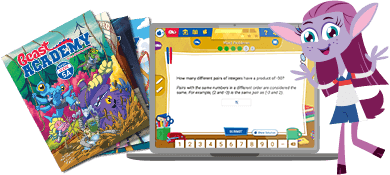Anywhere Nim
Take turns counting up by 1 or 2. Whoever says "10" wins!
Instructions
Waiting in line together? Driving? Cleaning together or picking up toys? This simple game works anywhere and can be modified for any age group or ability level.
Players take turns counting up from 1. On a turn, a player can say either 1 or 2 numbers. The player who says the target number of 10 wins the game.
For example, a game might play out like this:

Player A said 10, so they win the game!
There are many ways to change the rules of the games in order to practice different math skills. Players could skip-count, count to a higher target number, subtract instead of adding, or mix any of these. See Variations below for some specific ideas.
Anywhere Nim is a variation of the classic math game Nim (and so are other BA Playground activities, including Odd Knights as well as Bumper Cars).
Don't forget: it's Beast Academy Playground, not Beast Academy Study Hall. Change the rules, be silly, make mistakes, and try again. The Variations and Learning Notes are here for you if you want to dive deeper, but not all of them apply to learners of every age. The most important thing is to have fun.
What do you think of this activity?
We're always looking to improve. Submit your feedback to us below.
- none
- counting
- strategic thinking
- skip-counting
- MP1
- MP2
- MP7
- K.CC.A.1
- K.CC.A.2
- 1.OA.C.5
- 2.OA.B.2
- 2.NBT.A.2

Ready to level up?
Keep problem solving with Beast Academy’s full math curriculum for students ages 6–13. Check out our captivating comic book series and immersive online platform.
LEARN MOREBring problem-solving to your classroom
Keep your entire class engaged with a full book and online math curriculum, for students ages 6–13. 98% of teachers say they’re satisfied with Beast Academy.
LEARN MORE



Ready to level up?
Keep problem solving with Beast Academy’s full math curriculum for students ages 6–13. Check out our captivating comic book series and immersive online platform.
LEARN MOREBring problem-solving to your classroom
Keep your entire class engaged with a full book and online math curriculum, for students ages 6–13. 98% of teachers say they’re satisfied with Beast Academy.
LEARN MORE
Sign up to be notified when new videos are released.















































